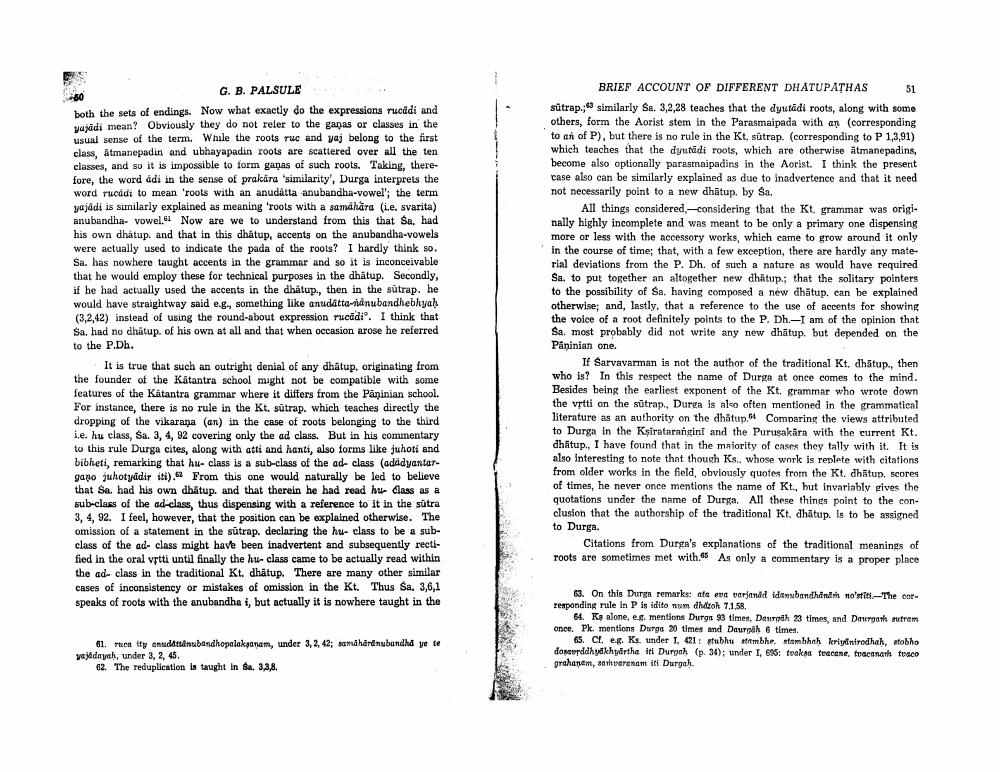Book Title: Brief Account Of Different Dhatupatras Author(s): G B Palsule Publisher: G B Palsule View full book textPage 8
________________ G. B. PALSULE both the sets of endings. Now what exactly do the expressions rueddi and yajadi mean? Obviously they do not reler to the ganas or classes in the usual sense of the term. While the roots rue and yaj belong to the first class. Itmanepadin and ubhayapadin roots are scattered over all the ten classes, and so it is impossible to form ganas of such roots. Taking, therefore, the word adi in the sense of prakara 'similarity', Durga interprets the word rucid: to mean 'roots with an anudatta anubandha-vowel'; the term yajadi is sunilarly explained as meaning "rools with a samahara (i.e. svarita) anubandha- vowel. Now are we to understand from this that Sa. had his own dhatup, and that in this dhatup, accents on the anubandha-vowels were actually used to indicate the pada of the roots? I hardly think so. Sa. has nowhere taught accents in the grammar and so it is inconceivable that he would employ these for technical purposes in the dhätup. Secondly, if he had actually used the accents in the dhátup, then in the sutrap. he would have straightway said e.g, something like anudattanubandhebhyal (3,2,42) instead of using the round-about expression rucadio. I think that Sa, had no dhätup of his own at all and that when occasion arose he referred to the P.Dh. It is true that such an outright denial of any dhatup, originating from the founder of the Katantra school might not be compatible with some features of the Kätantra grammar where it differs from the Paninian school. For instance, there is no rule in the Kt. sutrap. which teaches directly the dropping of the vikarana (an) in the case of roots belonging to the third 1.e. hu class, Sa. 3, 4, 92 covering only the ad class. But in his commentary to this rule Durga cites, along with atti and hanti, also forms like juhoti and bibheti, remarking that hu- class is a sub-class of the ad-class (adadyanlargapo juhotyddir iti). From this one would naturally be led to believe that Sa had his own ditup, and that therein he had read ha class as a sub-class of the ad-class, thus dispensing with a reference to it in the sutra 3, 4, 92. I feel, however, that the position can be explained otherwise. The omission of a statement in the sutrap. declaring the hu- class to be a subclass of the ad-class might have been inadvertent and subsequently rectified in the oral vytti until finally the hu-class came to be actually read within the ad-class in the traditional Kt. dhatup. There are many other similar cases of inconsistency or mistakes of omission in the Kt. Thus Sa. 3,6,1 speaks of roots with the anubandha i, but actually it is nowhere taught in the BRIEF ACCOUNT OF DIFFERENT DHATUPATHAS 51 sütrap;& similarly Sa. 3,2,28 teaches that the dyutadi roots, along with some others, form the Aorist stem in the Parasmaipada with an (corresponding to an of P), but there is no rule in the Kt, sutrap. (corresponding to P 1,3,91) which teaches that the dyitadi roots, which are otherwise atmanepadins, become also optionally parasmaipadins in the Aorist. I think the present case also can be similarly explained as due to inadvertence and that it need not necessarily point to a new dhatup. by Sa. All things considered, considering that the Kt. grammar was originally highly incomplete and was meant to be only a primary one dispensing more or less with the accessory works, which came to grow around it only in the course of time; that, with a few exception, there are hardly any material deviations from the P. Dh, of such a nature as would have required Sa. to put together an altogether new dhatup: that the solitary pointers to the possibility of Sa, having composed a new dhatup. can be explained otherwise; and, lastly, that a reference to the use of accents for showing the voice of a root definitely points to the P. D.-I am of the opinion that $a, most probably did not write any new dhatup, but depended on the Paninian one. If Sarvavarman is not the author of the traditional Kt, dhatup, then who is? In this respect the name of Durga at once comes to the mind. Besides being the earliest exponent of the Kt, grammar who wrote down the vrtti on the strap., Duren is also often mentioned in the grammatical literature as an authority on the dhatup. Comparing the views attributed to Durga in the Ksiratarangint and the Purusakira with the current Kt. dhātup., I have found that in the majority of cases they tally with it. It is also interesting to note that though Ks., whose work is replete with citations from older works in the field, obviously quotes from the Kt dhatup scores of times, he never once mentions the name of Kt, but invariably wives the quotations under the name of Durga. All these things point to the conclusion that the authorship of the traditional Kt. dhätup. is to be assigned to Durga. Citations from Durga's explanations of the traditional meanings of roots are sometimes met with. As only a commentary is a proper place 3. On this Dures remarks: ata era redd Idenband Mole notit-The core responding rule in Pis idite um dhidroh 7.1.58 64. Ky slone, e mentions Durgs 3 times. Deur 3 times and De n trem ance. Pk. mentions Durgs 20 times and Devrih 6 times 65. C. eg. Ks. under I el blu am bhe. sambhah Ieriylnirodhoh, obho dosuddhytkyrtha i Durgh (p. 34); under 16: took free free traco grahan , rencm ifi Durgah. arsbandha yete 61. runity audibandhopelakonan, under 3, 2, 42; m yejddayah, under 3, 2, 45. 62. The reduplication is taught in Sa. 3.2.8.Page Navigation
1 ... 6 7 8 9
